Best plants for butterflies: 16 nectar-rich flower and shrubs to grow
Grow the best plants for butterflies and you can lure these much-loved insets to your yard by providing them with all the nectar they will need


Add the best plants for butterflies to your garden and you'll soon get to enjoy the sight of these insects fluttering from flower to flower. You can attract as many as possible by growing the plants that provide them with food.
Gardens are a particularly important source of food during summer and early fall, but have an urgent role to play in butterfly conservation all year round. This is because butterfly numbers are down by over 75% since the 1970s due to habitat loss, pesticide use, and waterway pollution. Gardeners can help them out by learning how to grow a butterfly garden to provide them with habitat, shelter, and food.
Butterflies famously love buddleja (commonly known as the butterfly bush), resting on its honey-scented flower panicles to sup nectar in late summer and early fall. Along with other late-blooming food plants – such as aster and stonecrop – buddleja provides vital fuel for butterflies.
‘Some use the energy to migrate south, while others store it as fat to get them through the winter,’ says Anthony McCluskey at Butterfly Conservation. ‘Some butterflies are great long-distance flyers. Painted Lady butterflies can fly for thousands of miles on their annual migration and roam the countryside and towns looking for a pit-stop of nectar (such as buddleja and stonecrop) to help them on their way.’
16 plants for butterflies to include in your borders
When choosing where to include plants for butterflies in your plot, go for a site in sheltered sun to attract as many butterflies as possible.
Avoid using chemicals and provide sites for them to lay their eggs, such as a patch of long grass or a large container of nettles.
Give butterflies a helping hand and they will reward you with the wonderful sight of them feeding on your flowers in the sun.
1. Echinops bannaticus 'Taplow Blue’
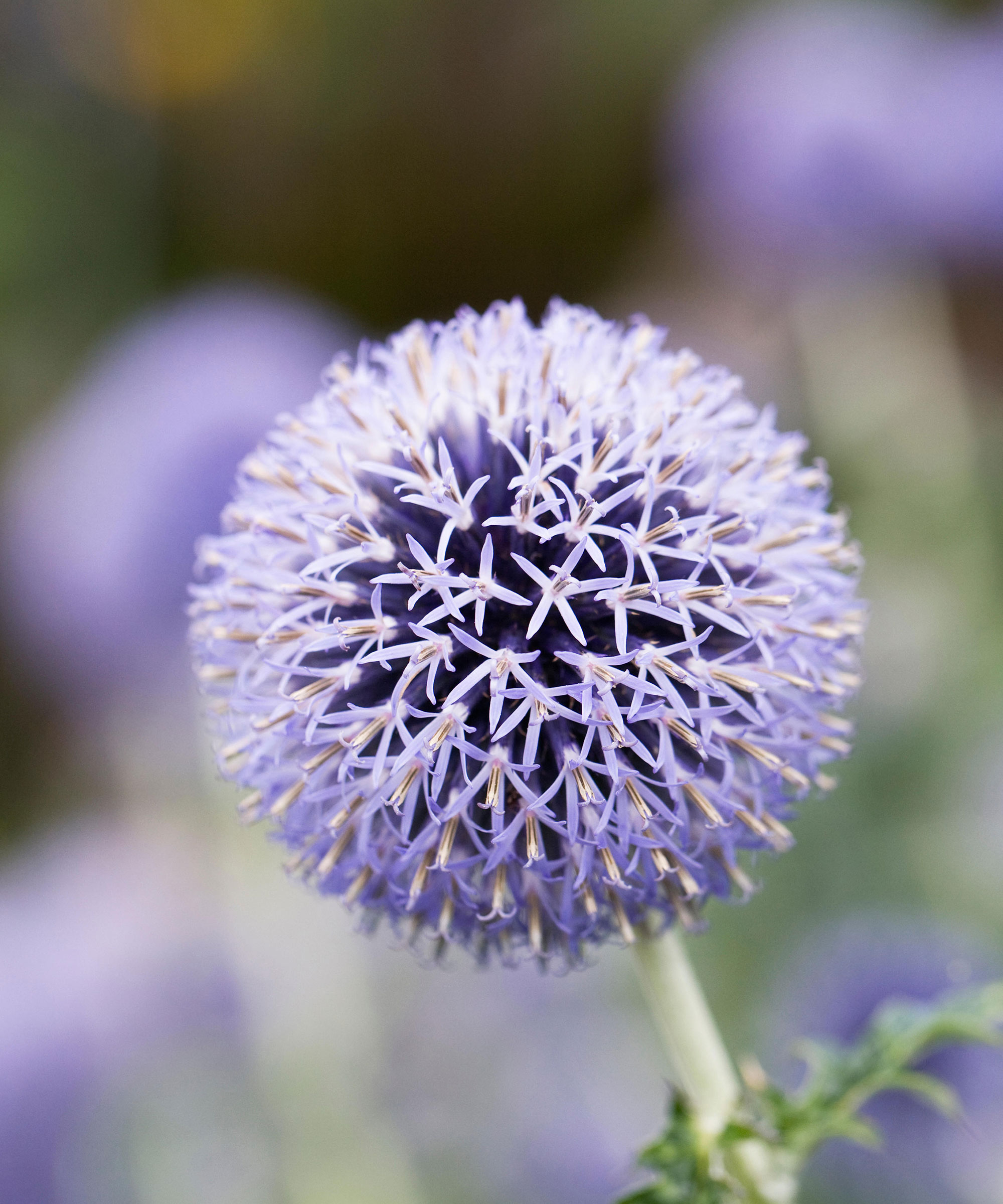
- Hardiness: USDA 3-8 (UK H7)
- Height: 4-6ft (1.2-1.8m)
- Spread: 2-3ft (60-90cm)
- Best for: Seedheads
Gorgeous spherical heads of silvery-blue flowers inject garden borders with architectural impact when this globe thistle blooms in late summer and early fall.
Once spent, the fabulous seedheads can be left for interest in fall and winter. To lure butterflies, grow this reliable perennial in well-drained soil in full sun, alongside other nectar-rich stalwarts, such as purple top and veronicastrum.
2. Eutrochium maculatum (Atropurpureum Group) ‘Riesenschirm’ AGM (syn. Eupatorium maculatum ‘Riesenschirm')

- Hardiness: USDA 4-8 (UK H7)
- Height: 6ft (1.8m)
- Spread: 3ft (90cm)
- Best for: Nectar
‘Eupatorium flowers in late summer and early fall and the larger butterflies such as Red Admiral and Peacock flock to it,’ says Anthony.
This tall perennial has dusky-pink blooms atop claret stems and pairs well with purple moor-grass 'Karl Foerster' in retentive, well-drained soil types in sun or semi-shade.
3. Verbena bonariensis AGM
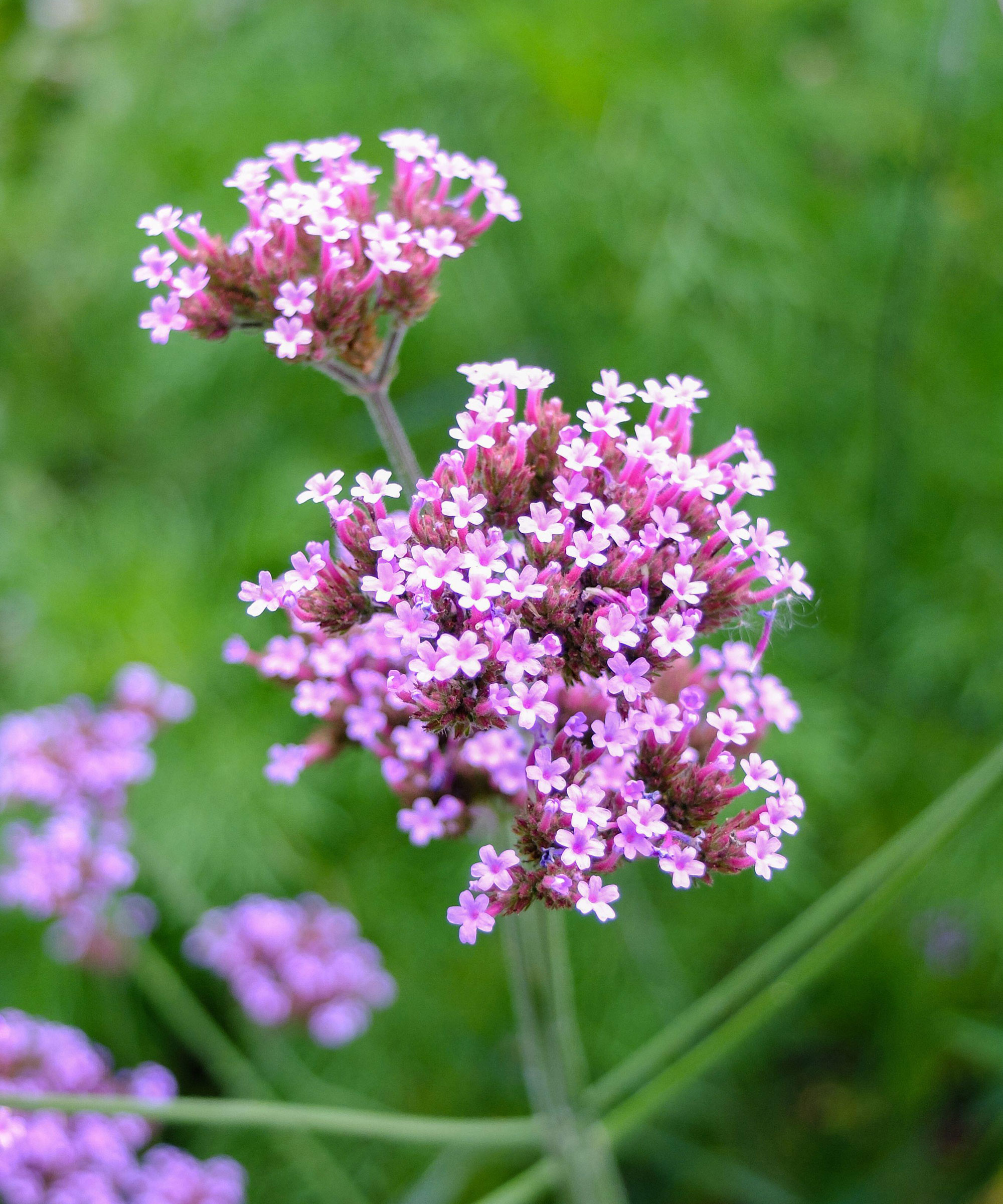
- Hardiness: USDA 7-11 (UK H4)
- Height: 6ft (1.8m)
- Spread: 18in (45cm)
- Best for: Airy flowers
Small clusters of purple flowers float atop tall, slender stems, forming a lightweight cloud of color in summer and fall.
Commonly known as purple top, this short-lived perennial has a see-through quality, which can be used to create layers in the border. Grow with Stipa gigantea in well-drained soil in sun.
A quick tip, however, is to make sure you wear long sleeves and gardening gloves to handle this plant, as the foliage can irritate skin.
4. Agastache ‘Blue Fortune’ AGM
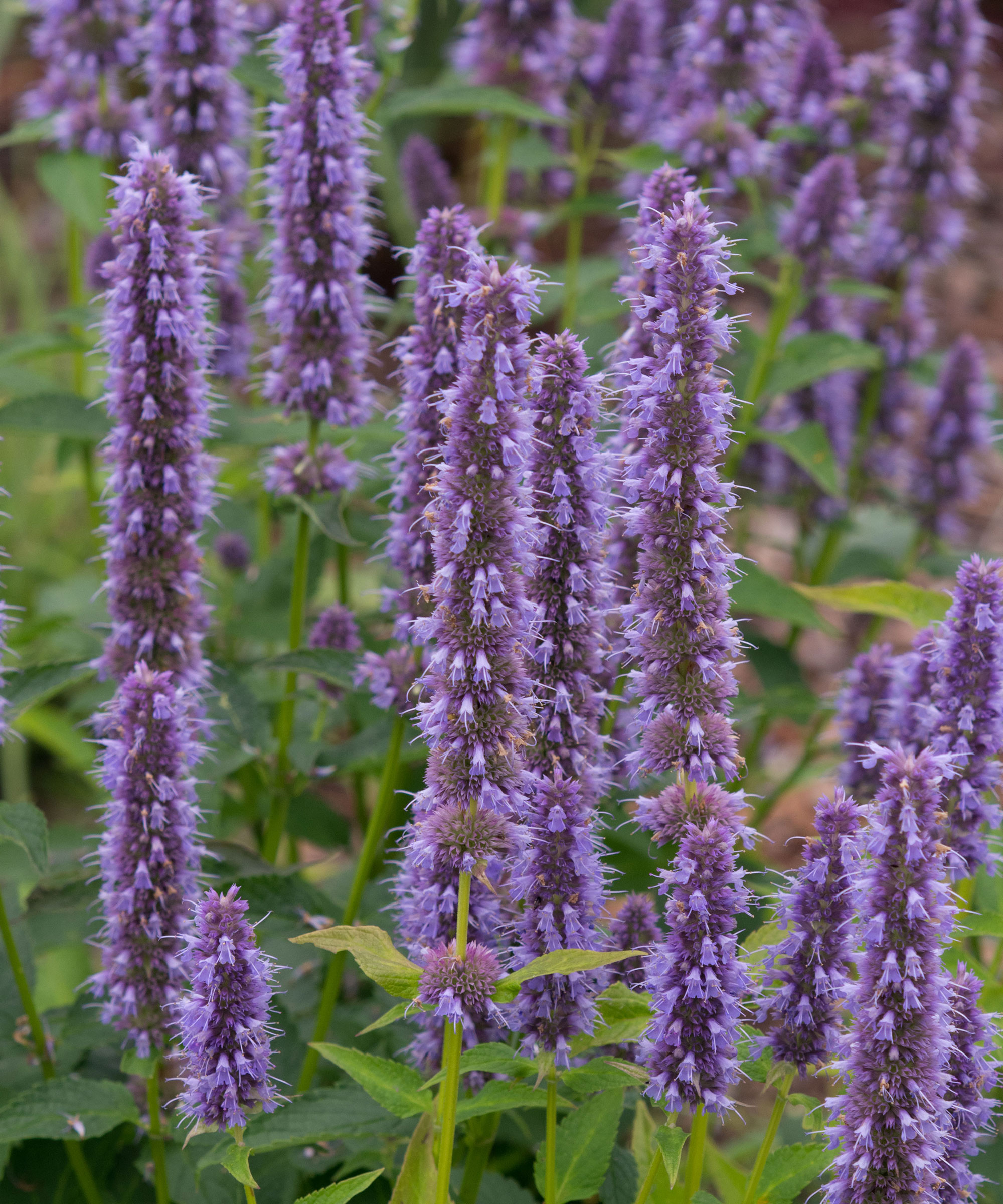
- Hardiness: USDA 5-9 (UK H6)
- Height: 3ft (90cm)
- Spread: 2.5ft (75cm)
- Best for: Aromatic foliage
A great plant for pollinators, this giant hyssop has violet-blue spikes of flowers that attract butterflies, above deliciously fragrant foliage, from mid summer to early fall.
It is a short-lived perennial that thrives with all types of heleniums in well-drained soil in sheltered sun. Neutral to alkaline soil is best, but it will tolerate poor acid soil or can be grown in pots. Do make sure you water regularly until established in dry areas.
5. Liatris spicata
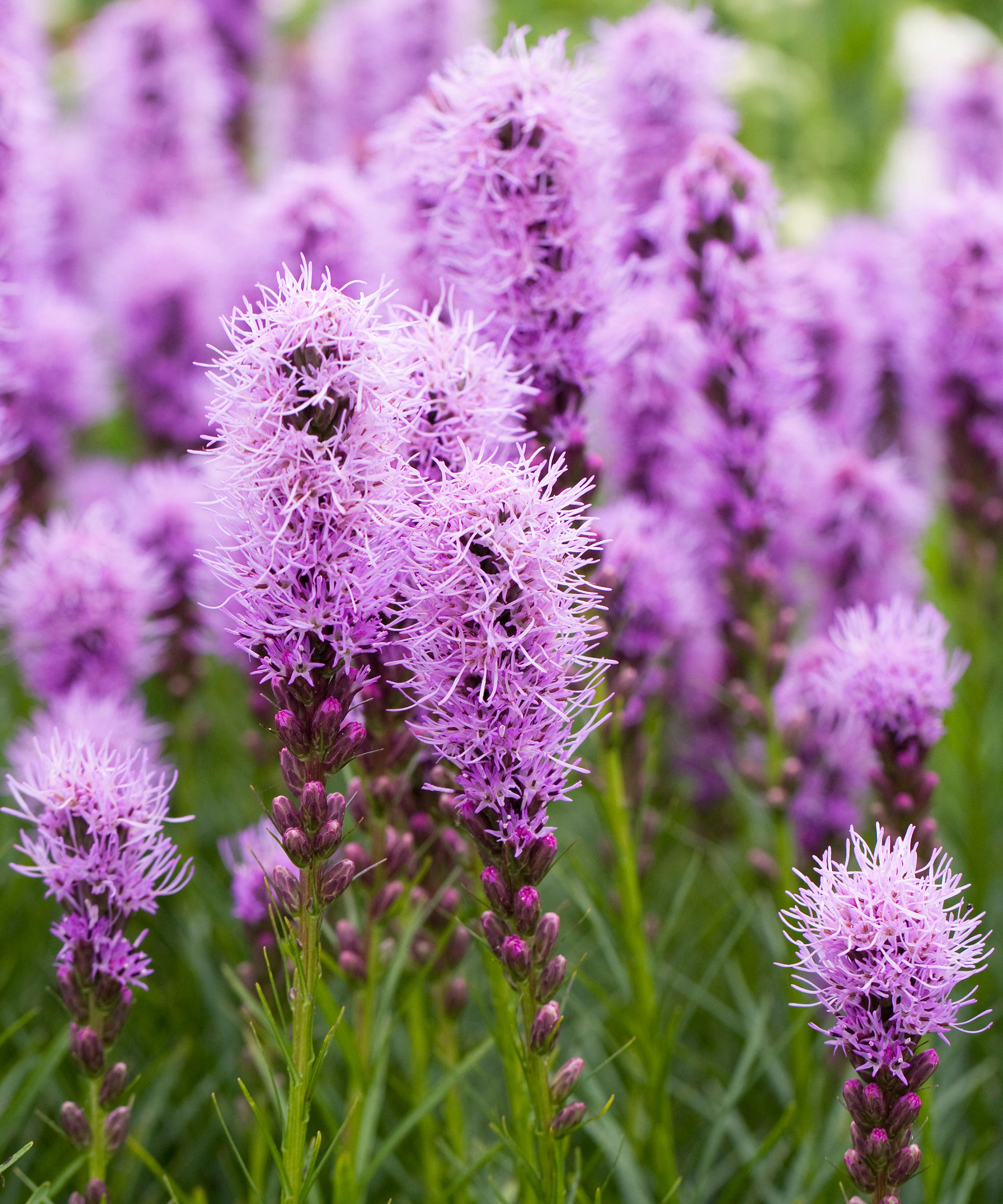
- Hardiness: USDA 3-8 (UK H7)
- Height: 2.5ft (75cm)
- Spread: 18in (45cm)
- Best for: Moist soil
One of the top plants for butterflies that's also loved by florists, the mauve-pink bottle-brush spires of the Kansas gayfeather are a delight in late summer and early fall. They rise from whorls of green grass-like leaves.
Best in a sunny spot in well-drained, fertile soil that retains moisture during the summer months, but is not waterlogged over winter. Pair this perennial with persicaria or echinacea in borders or grow in well-drained garden planters that are kept moist.
6. Echinacea purpurea
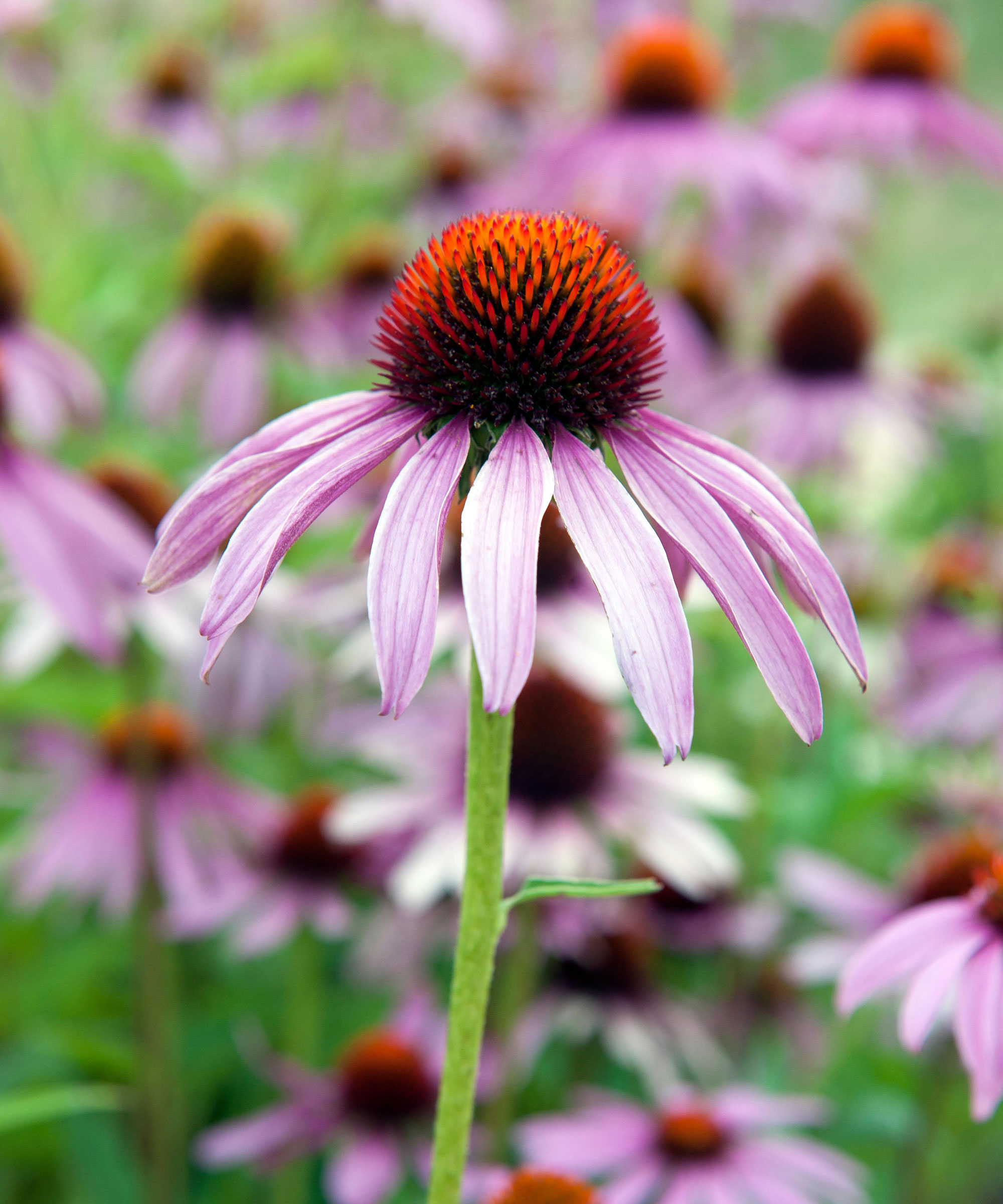
- Hardiness: USDA 3-8 (UK H5)
- Height: 3ft (90cm)
- Spread: 3ft (60cm)
- Best for: Prairie-style borders
The purple coneflower has large pink-mauve daisy blooms with reflexed petals that attract a range of butterflies from mid summer to early fall. They are followed by seedheads that feed finches in fall and winter, so are a great option if you also want to attract birds into your garden.
This coarse perennial grows wild in the prairies of the central and southeastern United States. Grow with Deschampsia cespitosa ‘Goldtau’ in well-drained soil in full sun.
7. Origanum laevigatum ‘Herrenhausen' AGM
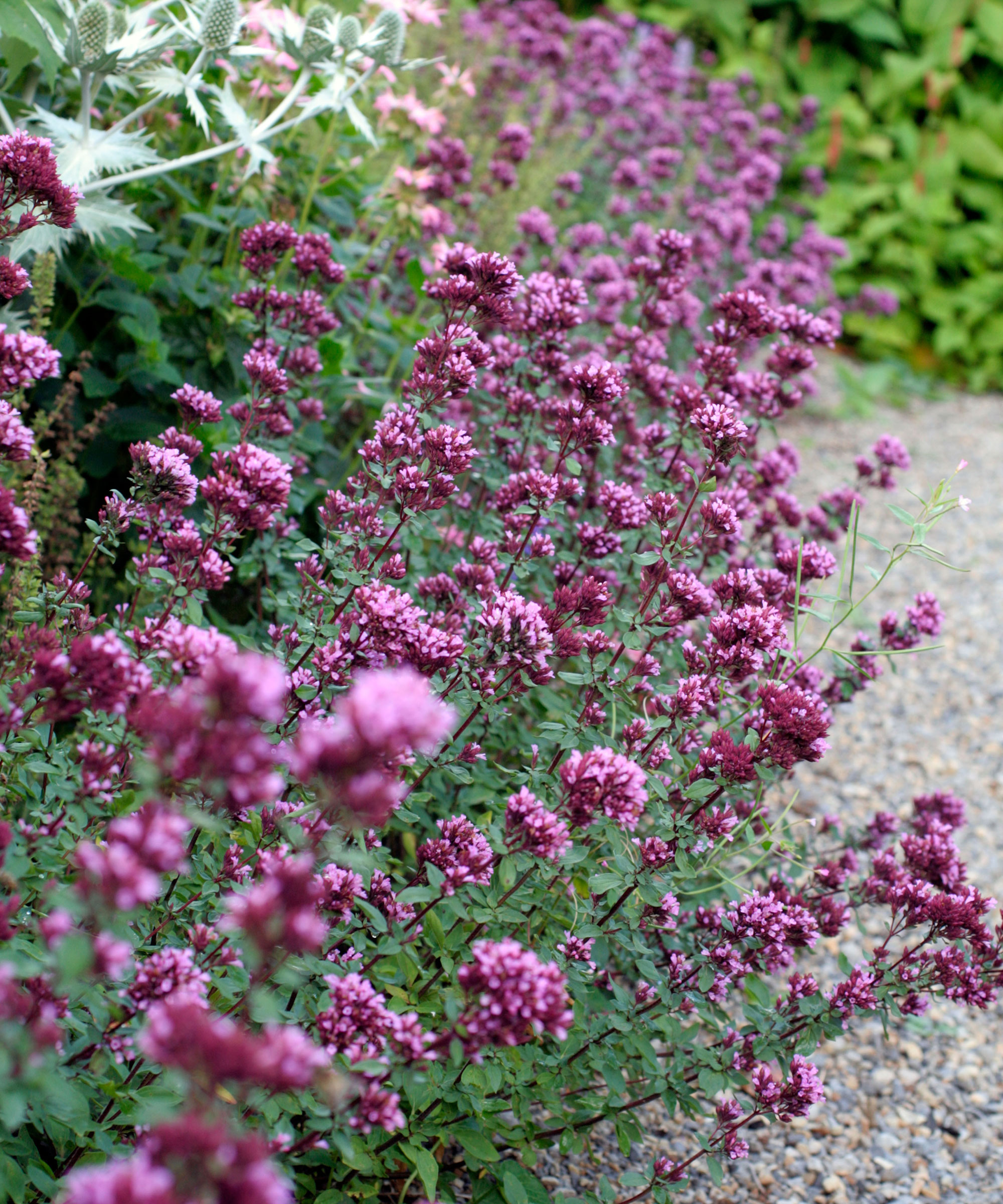
- Hardiness: USDA 5-9 (UK H6)
- Height: 18in (45cm)
- Spread: 3ft (60cm)
- Best for: Paths and paving
This decorative oregano has clumps of mauve-pink blooms atop wine-red stems, from mid summer into early fall.
Grow this herb at the edge of the border as an edging plant in light, well-drained neutral to alkaline soil in full sun, with compact types of ornamental grass (such as Stipa tenuissima) and border stonecrop (Hylotelephium).
It's worth noting that origanum majorana is the best form for cooking.
8. Allium lusitanicum (syn. ‘Summer Beauty’ and A. senescens subsp. montanum)

- Hardiness: USDA 5-9 (UK H6)
- Height: 18in (45cm)
- Spread: 12in (30cm)
- Best for: Well-drained soil
The adorable Portuguese allium produces pretty pale mauve-pink flower spheres that lure butterflies in late summer, above glaucous onion-scented foliage.
Hailing from mountain slopes, it requires very well-drained soil, in sun or semi-shade, and pairs well with lamb’s ear. Deadheading flowers is essential if you want to prevent this bulb spreading.
9. Scabiosa caucasica 'Clive Greaves’ AGM
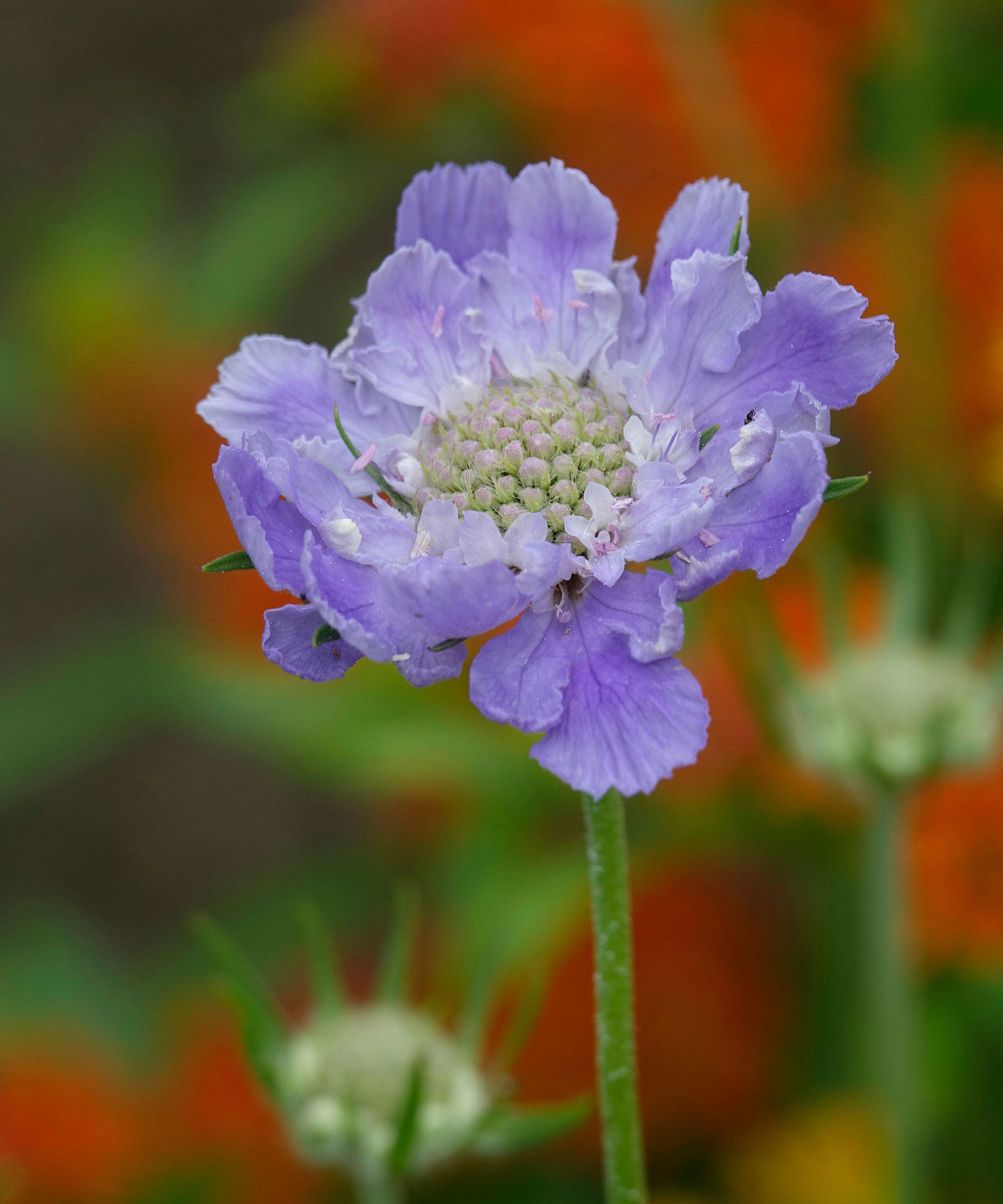
- Hardiness: USDA 3-7 (UK H4)
- Height: 2ft (60cm)
- Spread: 12in (30cm)
- Best for: Cottage gardens
A charming scabious with pastel-blue pincushion flowers on very slender stems, throughout summer.
Ideal for including in cottage garden ideas, it makes a great cut flower. Thanks to its see-through quality, this perennial can be used for layering in the border but it will require an open position with good air flow to prevent mildew.
Pairs well with stonecrop ‘Matrona’ in neutral to alkaline well-drained soil in full sun.
10. Symphyotrichum 'Little Carlow’ AGM (syn. Aster ‘Little Carlow’)
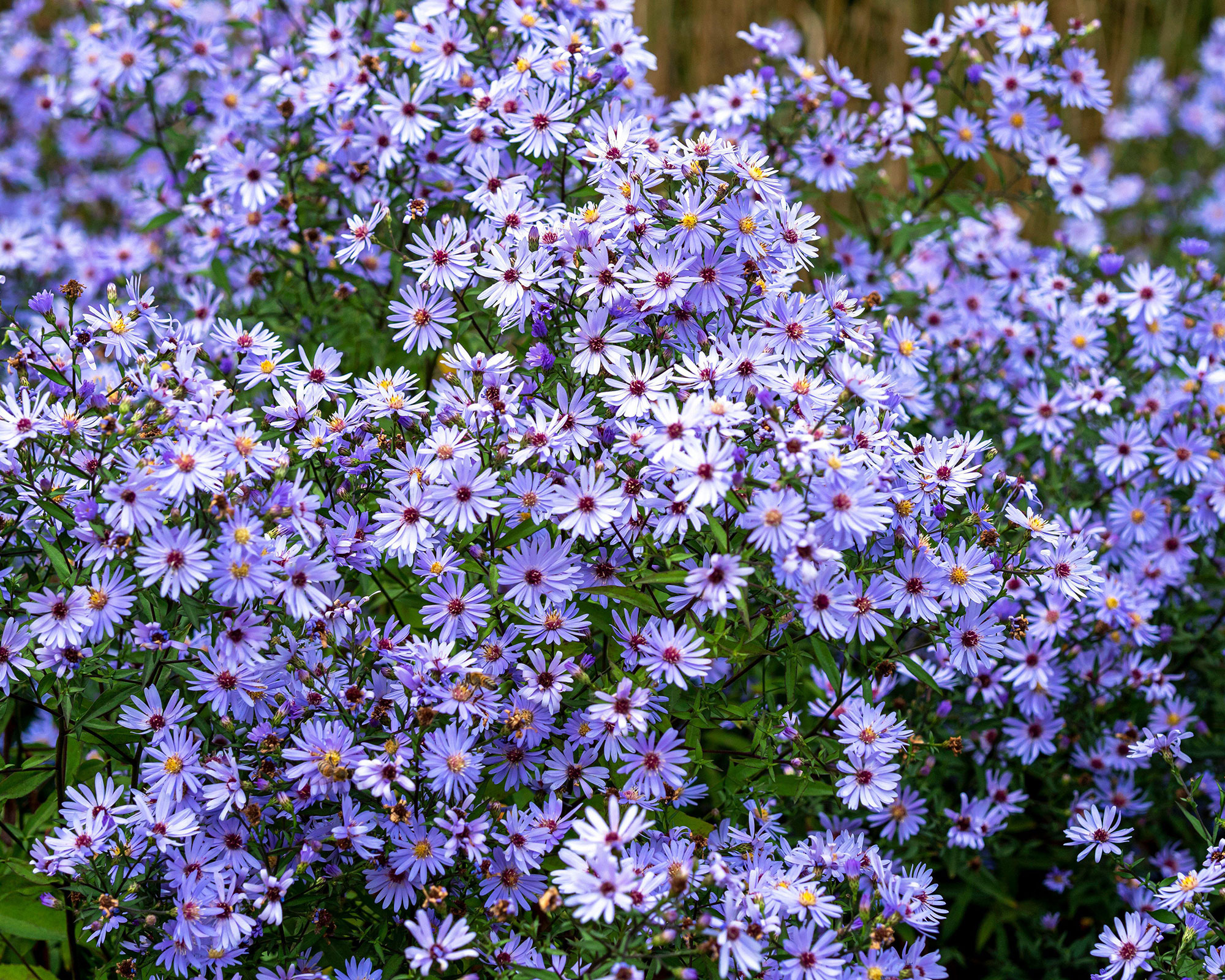
- Hardiness: USDA 4-8 (UK H7)
- Height: 3ft (90cm)
- Spread: 2.5ft (75cm)
- Best for: Bees
Gorgeous dense flowering stems adorn this bee-friendly plant from late summer into mid fall, providing vital color when the seasons change.
Butterflies (as well as bees) visit the mass of violet-blue daisies with golden stamens, which pair well with other perennials, such as heleniums. Plant this perennial in an open, airy spot to prevent mildew, in sun or semi-shade.
11. Hylotelephium spectabile AGM
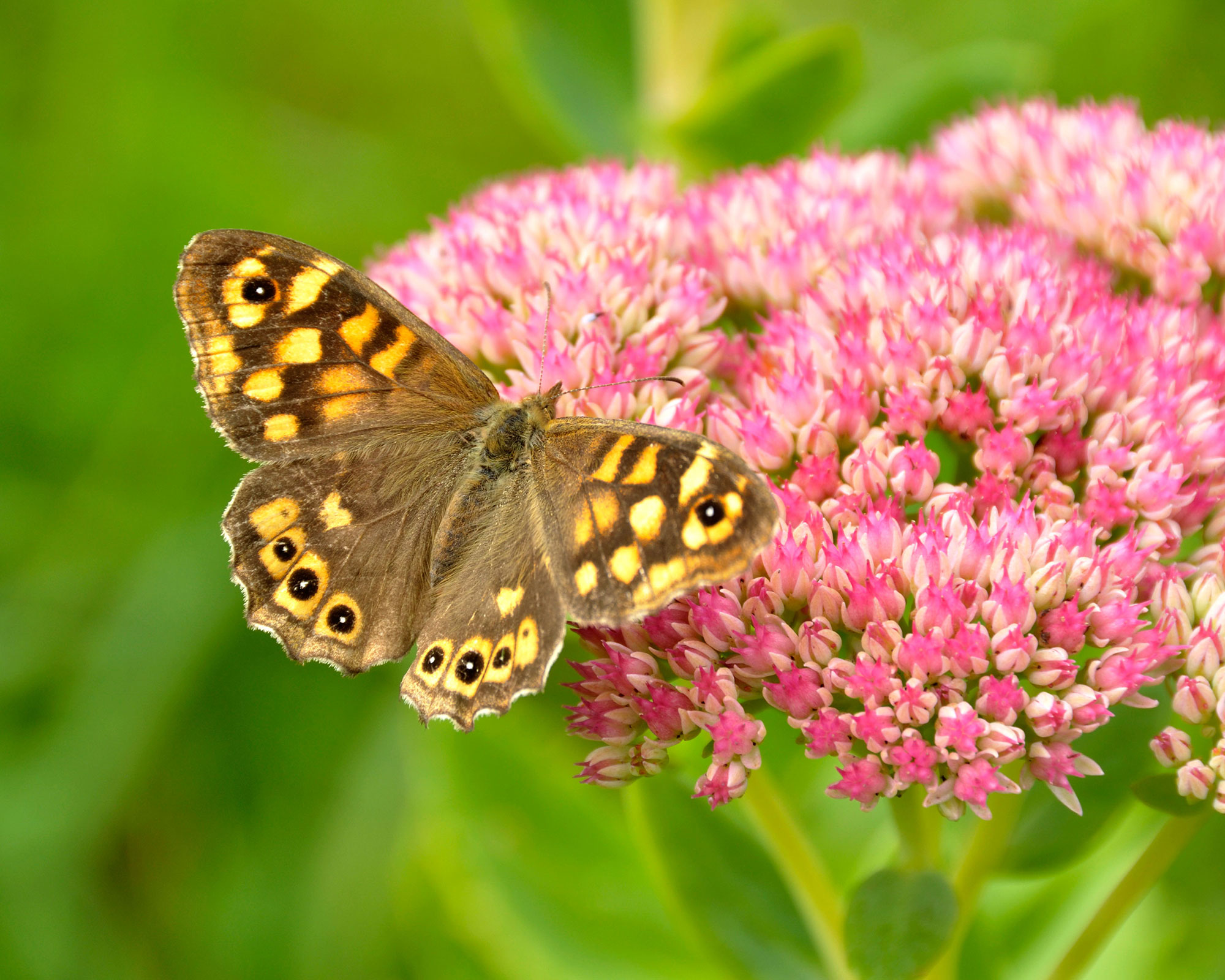
- Hardiness: USDA 3-9 (UK H7)
- Height: 18in (45cm)
- Spread: 18in (45cm)
- Best for: Poor soil
The ice plant is an excellent border stonecrop with a fleshy mound of pale-green foliage and flat heads of dusky-pink flowers in late summer and early fall.
These morph into attractive seedheads that add interest through late fall and winter and provide a habitat for insects. Grow in well-drained poor soil in sun with decorative oregano and Anemanthele lessoniana.
12. Dahlia Happy Single Juliet
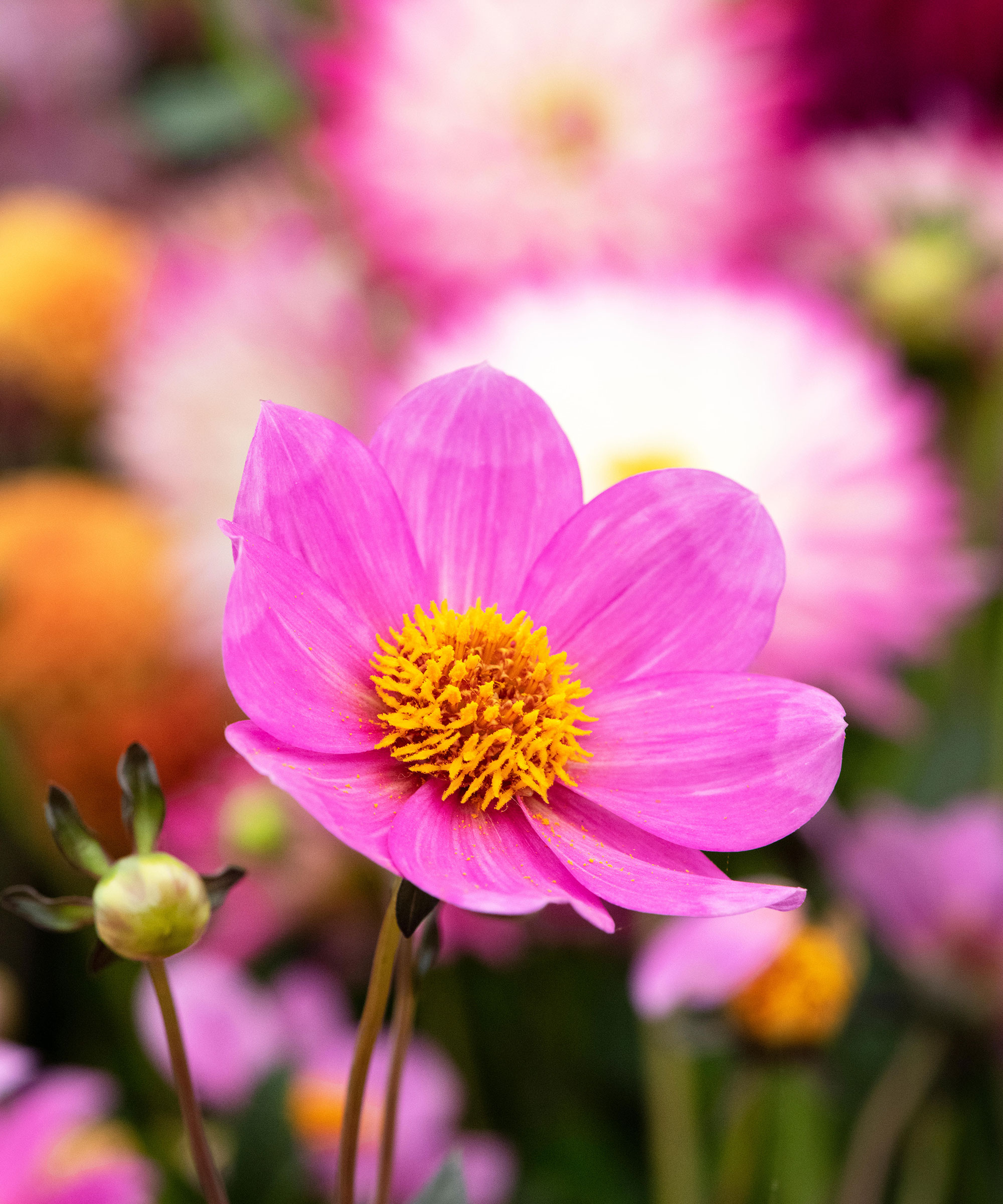
- Hardiness: USDA 7-10 (UK H3)
- Height: 3ft (90cm)
- Spread: 18in (45cm)
- Best for: Cut flowers
Butterflies love the rich purple-pink flowers of this type of dahlia, which will bloom from mid summer until the first frosts, if regularly cut for the vase.
Grow with Mexican sunflowers in humus-rich fertile, well-drained soil in sun. In cold areas, lift and store the tubers indoors; in milder parts of the UK and places with similar climates, cut the plants back in late fall and cover with a mound of mulch.
13. Buddleja davidii ‘Black Knight’ AGM
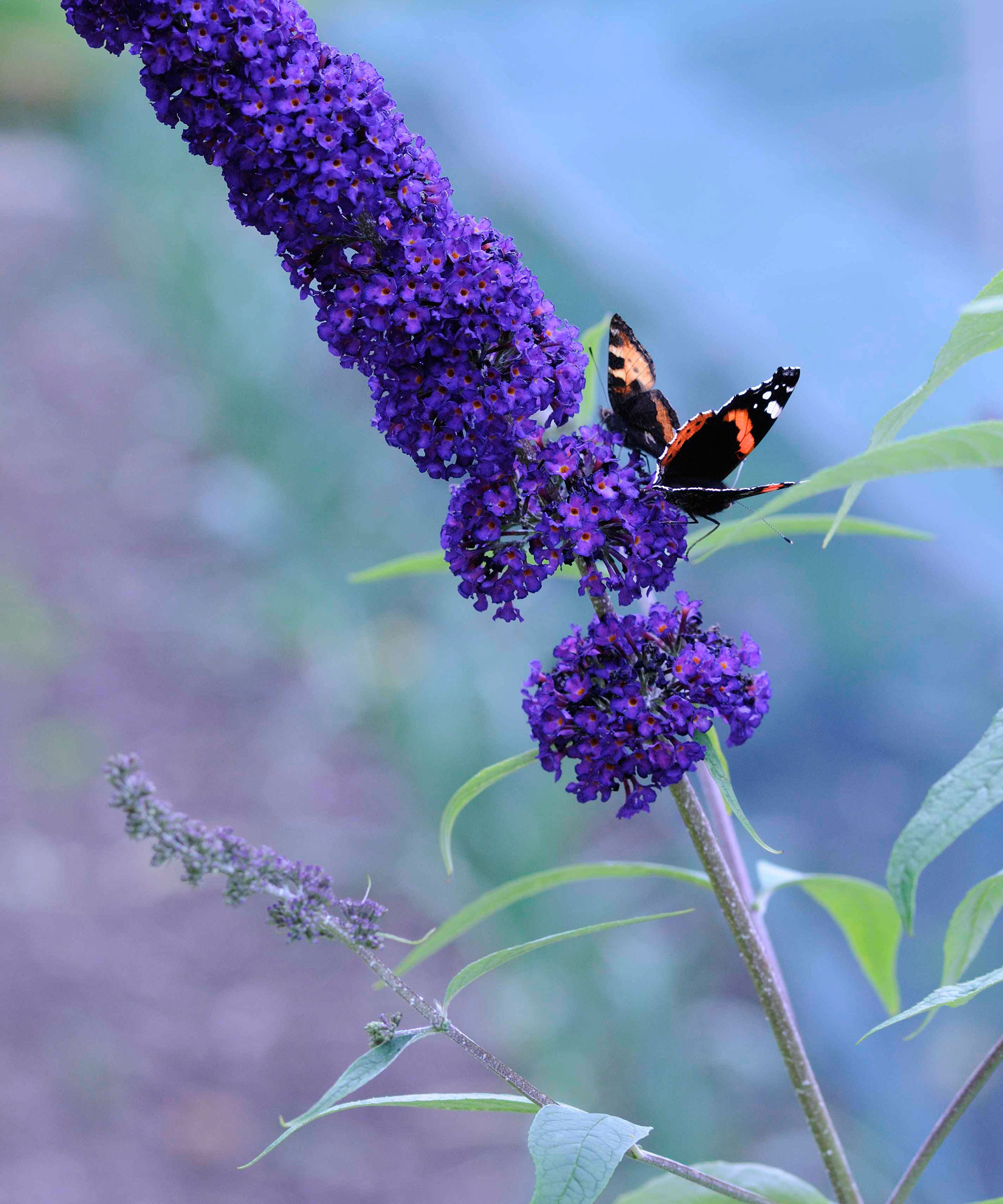
- Hardiness: USDA 5-9 (UK H6)
- Height: 10ft (3m)
- Spread: 10ft (3m)
- Best for: Color
One of the best known plants for butterflies, this features fabulous bold-purple flower panicles that smell of honey, providing nectar for a huge range of butterflies from mid summer to early fall.
Plant this deciduous summer flowering shrub in a sheltered sunny spot to attract as many butterflies as possible. Cut back hard every year in late winter or early spring.
Buddleja can be considered an invasive plant in some parts of the United States, so check its status in your area before planting.
14. Lavandula x intermedia ‘Sussex’ AGM
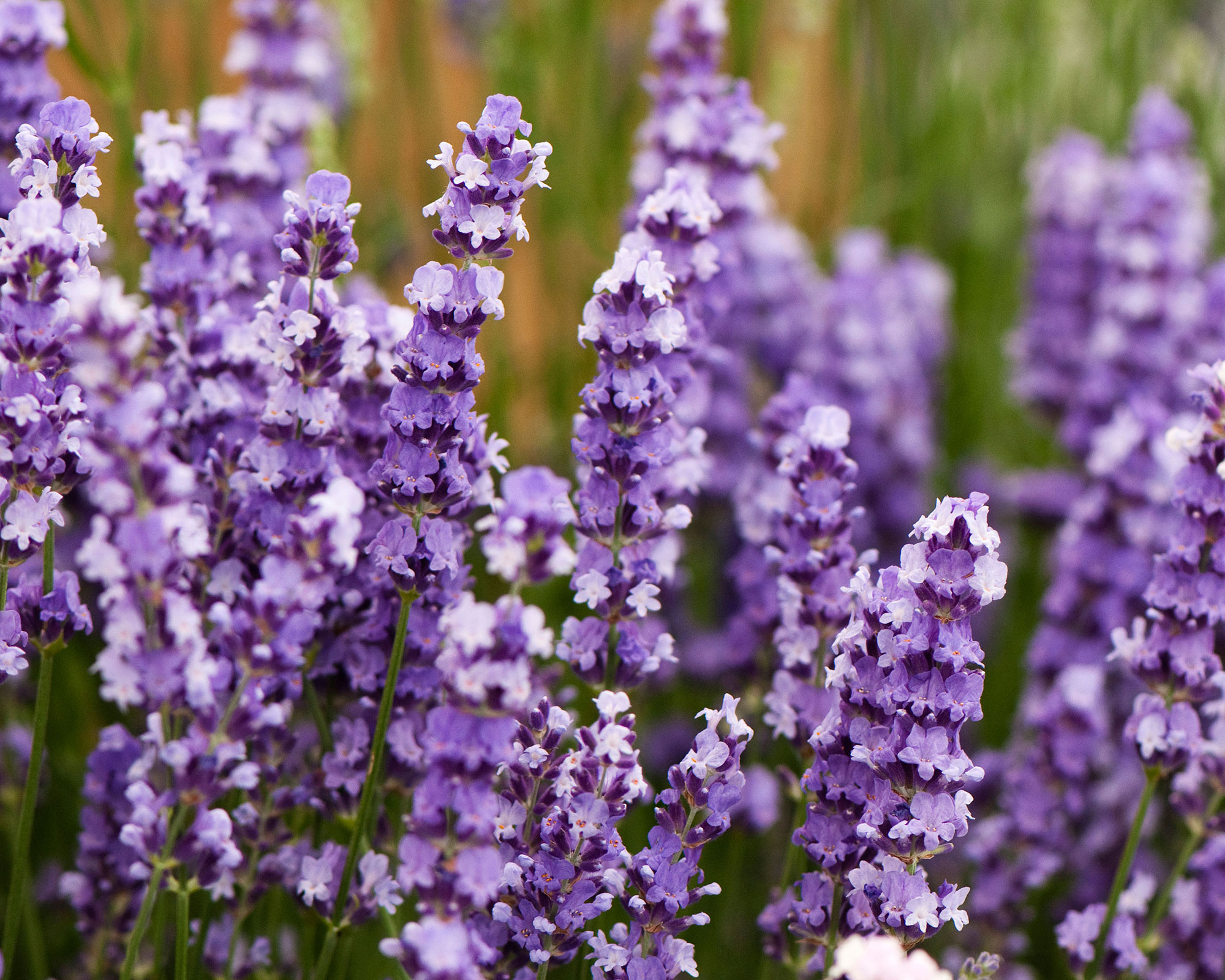
- Hardiness: USDA 5-8 (UK H5)
- Height: 2.5ft (75cm)
- Spread: 4ft (1.2m)
- Best for: Dried flowers
The tall, hardy intermedia lavenders are farmed for oil and attract a wealth of pollinators. This wonderful variety has an abundance of long pale blue-purple flower spikes above aromatic evergreen leaves throughout summer.
Grow with your favorite cistus varieties or as a low hedge in very well-drained soil in full sun. Clip in mid spring and after flowering to keep the plant smart and healthy.
15. Buddleja globosa AGM
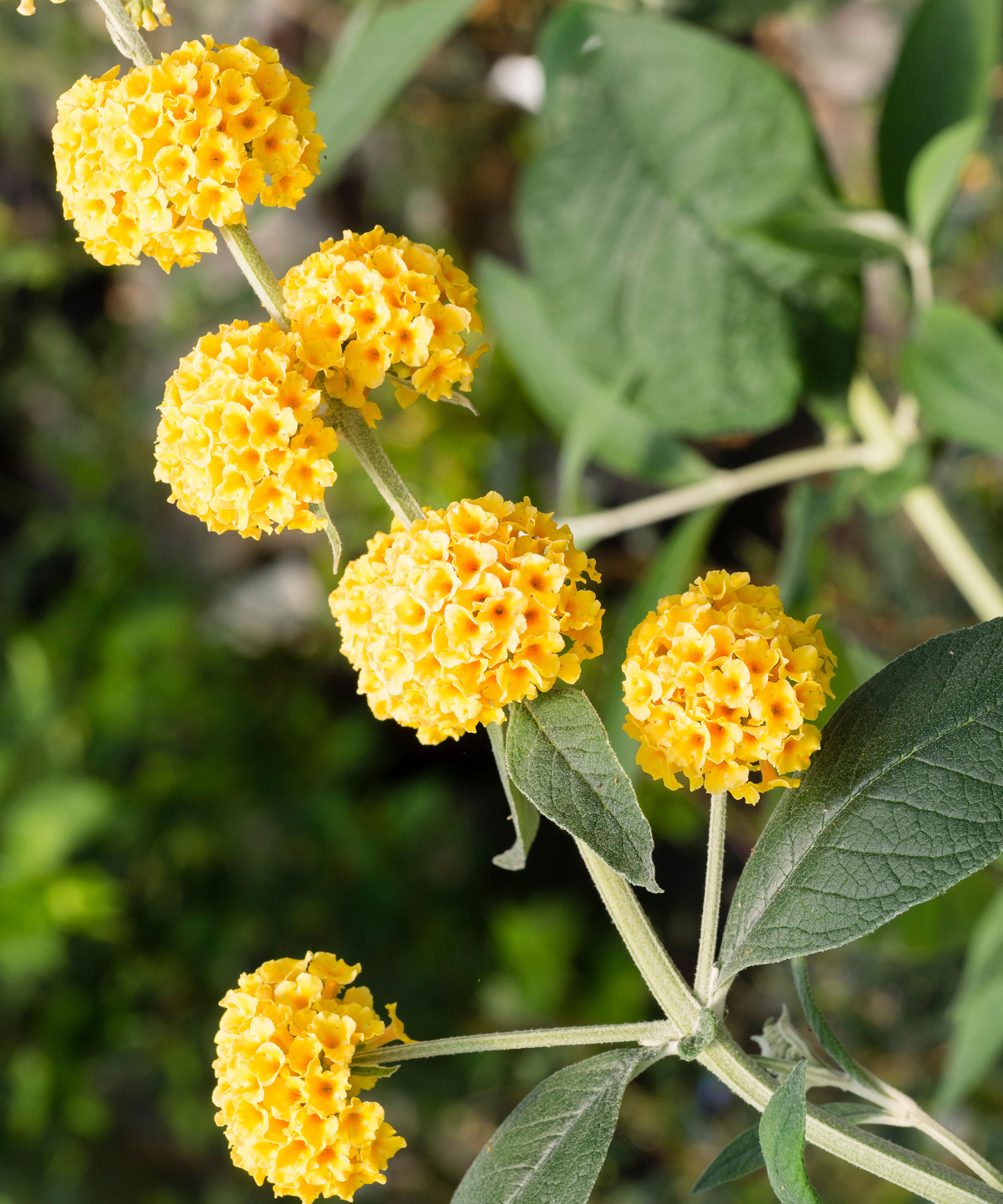
- Height: 16ft (5m)
- Spread: 16ft (5m)
- Best for: Architectural impact
The splendid flowerheads of the Chilean orange ball tree are amber-colored globes that lure butterflies from late spring to mid summer.
This shrub is semi-evergreen, retaining its leaves in mild winters, and can be trained to form a small tree. It does not like too much pruning – if you have a garden big enough for its eventual size, enjoy it in well-drained soil in sheltered full sun.
16. Caryopteris × clandonensis 'Heavenly Blue'
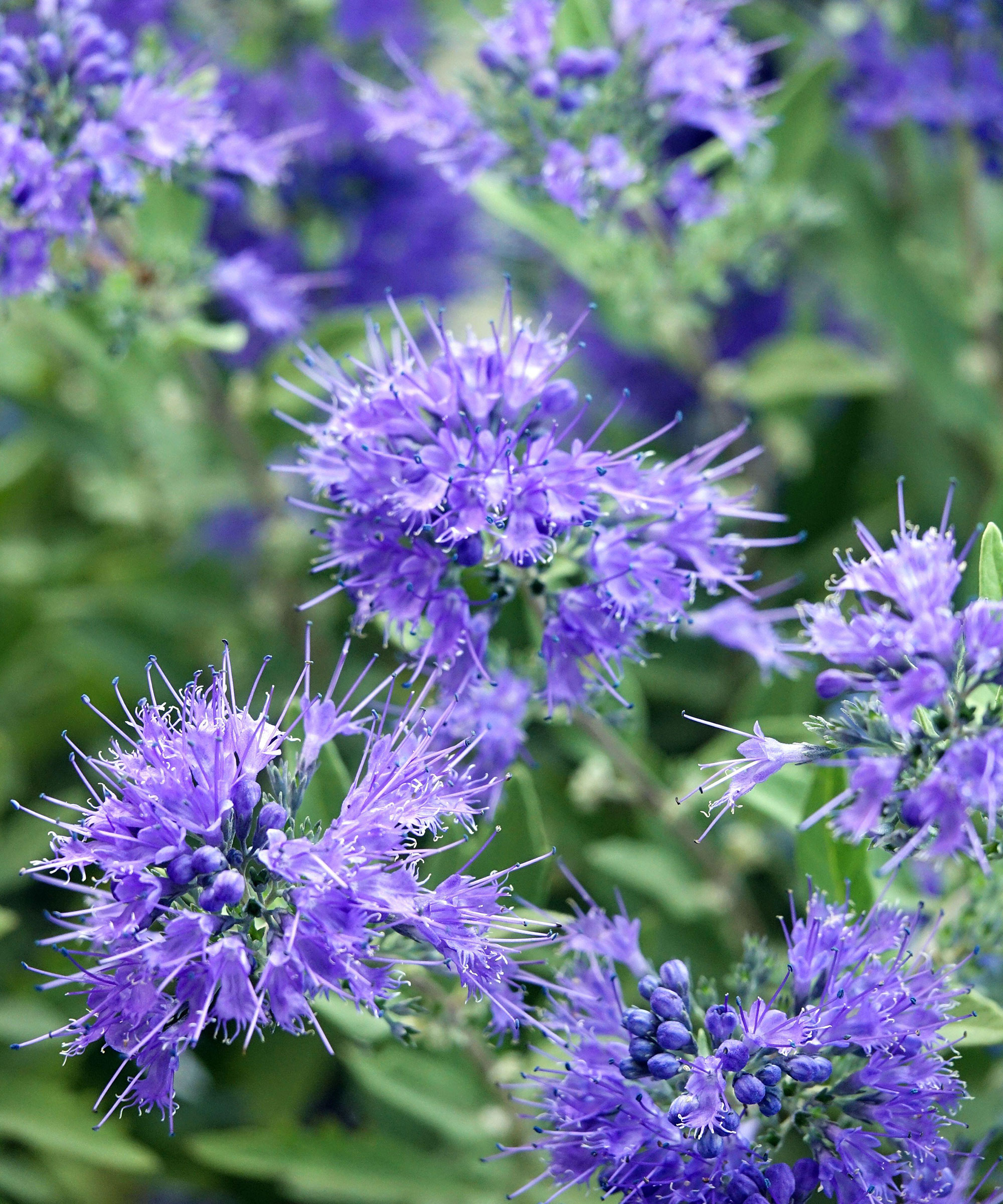
- Hardiness: USDA 5-9 (UK H4)
- Height: 3ft (90cm)
- Spread: 3ft (90cm)
- Best for: Small gardens
This bluebeard is an upright mound of violet-blue in late summer and early fall. A good choice for small gardens, it is a compact deciduous shrub with arching branches of silvery leaves that are tipped with fluffy blue blooms that lure butterflies.
Best in well-drained, light, fertile soil in sun; in cold areas, it must be grown against a warm, sheltered garden wall. Cut back in early spring.
What plant attracts the most butterflies?
Buddleja (commonly known as the butterfly bush) attracts a huge range of butterflies, including Red Admiral, Peacock, Painted Lady, and Tortoiseshell, from mid summer to early fall.
The widely available forms of Buddleja davidii (such as ‘Royal Red’ and ‘Lochinch’) are easy to grow in sun, requiring a hard prune in late winter or early spring. They reach around 10ft (3m), but there are dwarf forms of buddleja (such as the Flutterby and Buzz series), which can be grown in pots as part of your container gardening ideas.
You'll find plenty of tips on pruning buddleja in our dedicated guide too.
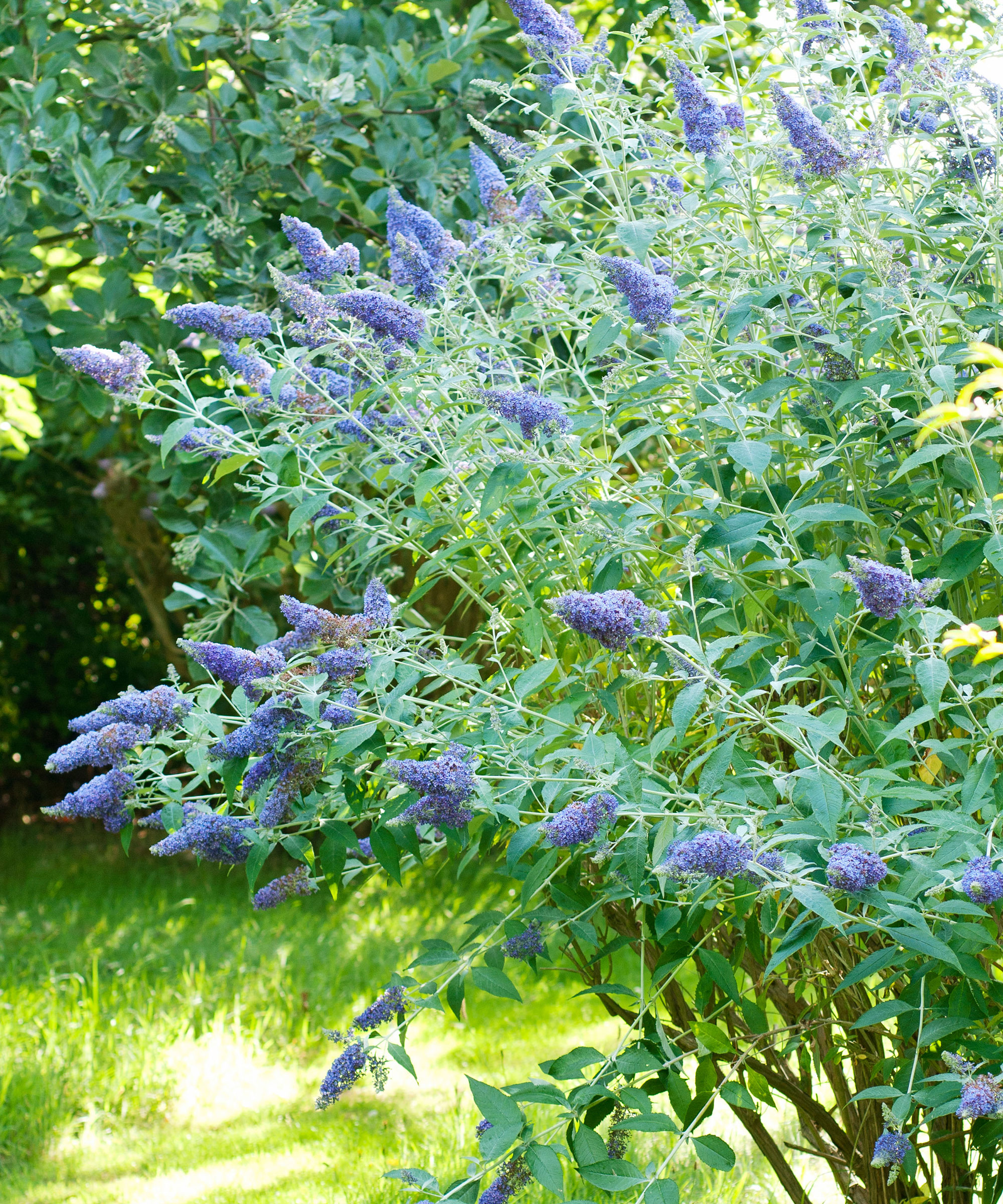
What flower do butterflies like the most?
‘Most butterflies have a long proboscis for drinking nectar, meaning they can feed from flowers that shorter-tongued insects like bees can’t access,’ says Anthony McCluskey at Butterfly Conservation. ‘Phlox and Sweet Williams are two examples. And all species are happy on flowers with large heads that they can land on to feed, such as scabious and cardoon.’
Butterflies also adore Origanum (oregano and marjoram), which can be grown at the front of the border or in the cracks and crevices of patio paving, steps, and walls. It has pink or purple blooms in clusters from early summer to early fall and often seeds itself around the garden. ‘Herrenhausen’, ‘Pilgrim’, and ‘Rosenkuppel’ are good garden forms. Grow them in well-drained soil in full sun.

What potted plants do butterflies like?
English lavender (Lavandula angustifolia) is a good option for any summer container ideas as it will grow well in pots and butterflies love the beautifully aromatic summer flowers.
Select a pot with plenty of drainage holes (because lavender loathes being waterlogged) and a compact variety, such as ‘Purity’ (white) or ‘Purple Treasure’ (violet-blue), which reach 15in (40cm). Plant in a mix of peat-free compost and grit and place in full sun.
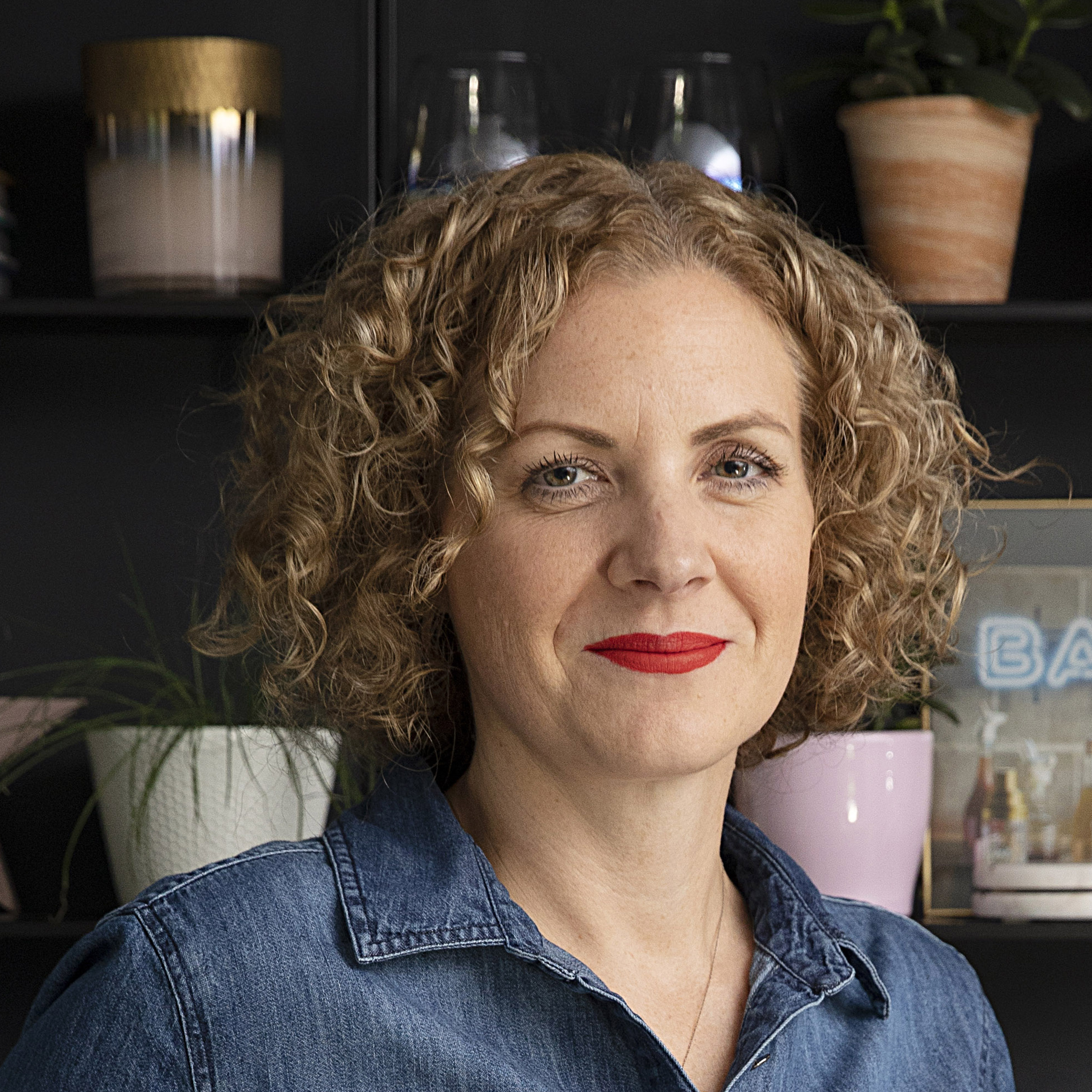
For the past 18 years, Beth has worked for and contributed to a number of leading magazines in the UK, including Real Homes, Ideal Home, Period Living, Grand Designs and Good Homes amongst others. Now the editor of Gardeningetc.com, Beth's attention is firmly outdoors. Her own garden is a really important part of her family's home, and she loves spending time tending to the veg patch or entertaining friends and family at a summer BBQ or alfresco pizza night.
